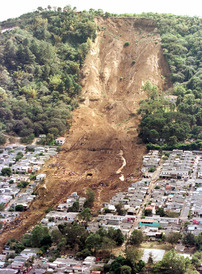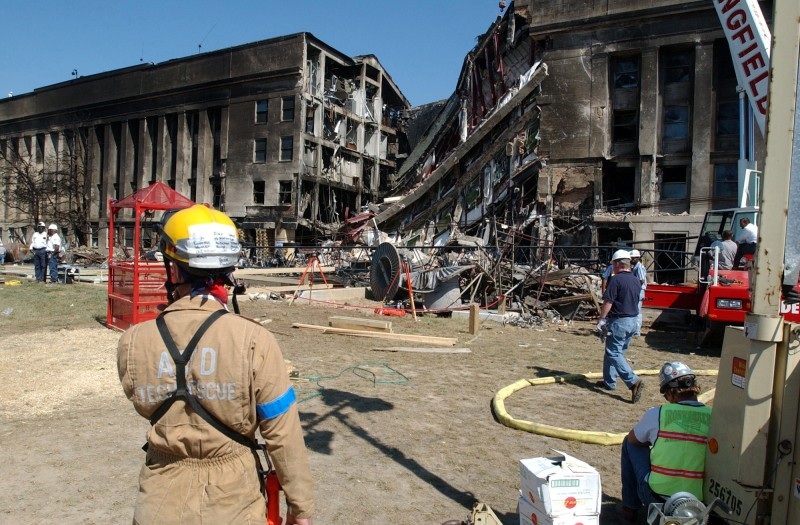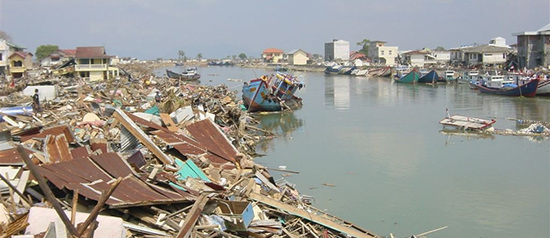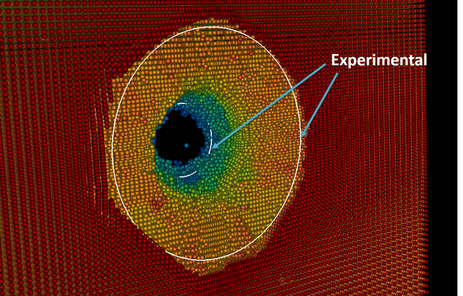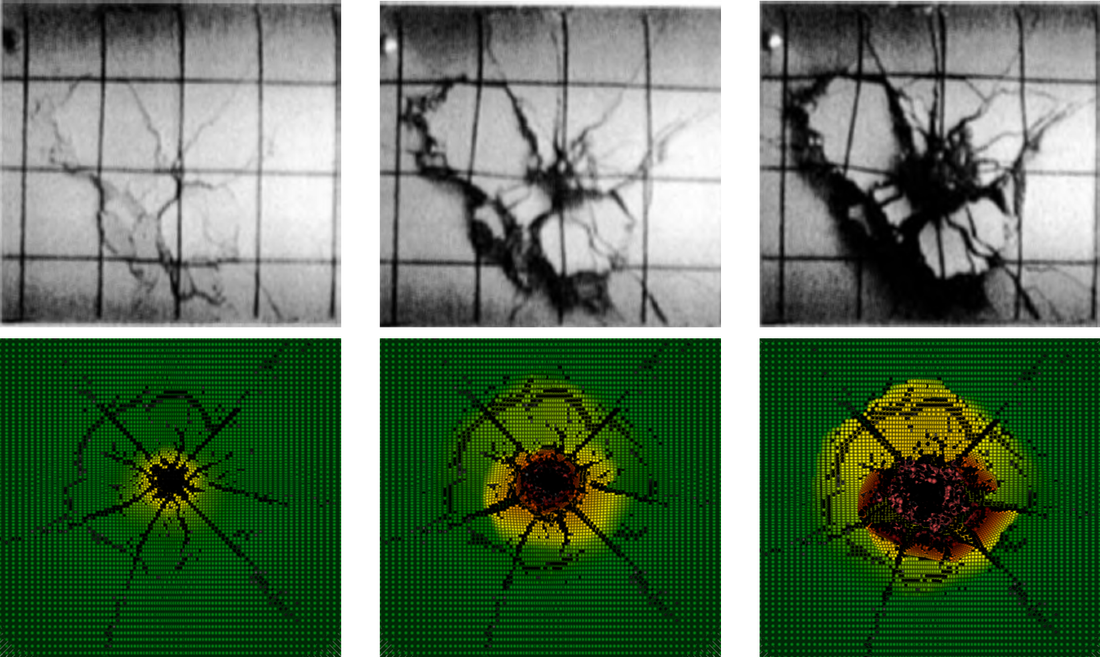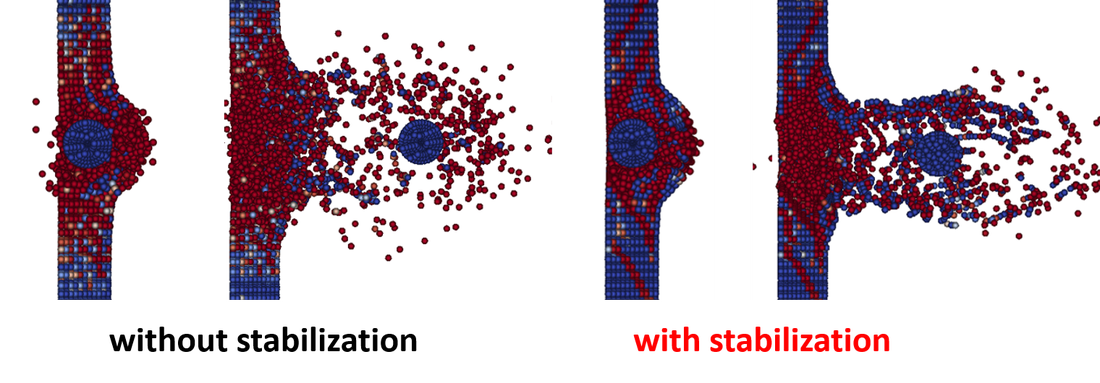Computational formulations for natural and man-made disasters
|
Disasters, whether naturally occurring such as earthquakes, landslides, tsunamis, and storms, or man-made, e.g. those resulting from terrorism, contribute to a significant loss of life and property nationally and globally. Death tolls from one single natural disaster can range in the hundreds of thousands; cumulative tolls for man-made disasters (such as those during the war on terror) can be on the same magnitude. Effective numerical methods facilitate the advancement of protection against these disasters. My primary research focus is the development of robust and efficient numerical methods for extremely large deformation problems such as blast, fragment-impact processes and systems and components undergoing extreme conditions.
|
|
Perforation of a concrete block using a stabilized meshfree method
Numerical and experimental crater and hole
qualitative comparison of fragmentation in penetration event
|
I have developed a computational formulation called variationally consistent integration [1,2] to achieve high accuracy with low order domain integration for meshfree methods such as the reproducing kernel particle method (RKPM) [3,4], which alleviates the efficiency bottleneck associated with quadrature. It enables accurate and efficient simulations of material damage processes and structural failure, earth moving, damage assessment of landslides, and structures subjected to man-made and natural disasters. This research has been implemented into large-scale computational codes used by the Army ERDC, and Sandia National Laboratories, to model bullet penetration into geomaterials (concrete, soil) to numerically investigate damage mechanisms in these events, and facilitate advancement in protective structures. Simulation results have been validated under blind test prediction for various sizes of targets, projectile sizes, and velocities (figures to the left). Slope stability analyses (figure below), as well as simulations of full scale earth moving for Caterpillar have also been performed using the stabilized RKPM method J.S. Chen and I have developed [2,5-7].
Triggering of landslide due to 1989 Loma Prieta Earthquake
Subsequently, I developed an accelerated meshfree method [6], that exhibits high accuracy, stability, and very low computational cost (20x faster than previous methods), with excellent performance in large deformation problems involving fragment-impact and penetration, blast-loaded structures, slope stability, and metal forming problems (figures below).
|
Perforation problem with and without stabilization (tensile damage)
Steel plate subject to blast loading from the UCSD extreme event simulator
Overview and technical summary (article)
A great technical summary of this work can be found in this IACM Expressions article.
A great technical summary of this work can be found in this IACM Expressions article.
| 2016_expressions.pdf | |
| File Size: | 28271 kb |
| File Type: | |
References
[1] Chen, J. S., Hillman, M., Ruter, M., An arbitrary order variationally consistent method for Galerkin meshfree methods, International Journal for Numerical Methods in Engineering, Vol. 95, pp. 387-418, 2013, doi:10.1002/nme.4512.
[2] Hillman, M., Chen, J. S., Stabilized and variationally consistent nodal integration for meshfree modeling of impact problems, Computational Particle Mechanics, Vol. 1, pp. 245-256, 2014, doi:10.1007/s40571-014-0024-5.
[3] Liu, W. K., Jun, S., Zhang, Y. F.. Reproducing kernel particle methods. International Journal for Numerical Methods in Fluids, Vol. 20, pp. 1081-1106, 1995, doi: 10.1002/fld.1650200824.
[4] Chen, J.S., Pan, C., Wu, C.T., Liu, W. K. Reproducing Kernel Particle Methods for large deformation analysis of non-linear structures. Computer Methods in Applied Mechanics and Engineering, Vol 139, pp. 195–227, 1996, doi:10.1016/S0045-7825(96)01083-3.
[5] Sherburn, J.A.,Roth M.J. , Chen, J.S., Hillman, M., Meshfree modeling of concrete slab perforation using a reproducing kernel particle impact and penetration formulation, Int. J. Impact Eng. 86 (2015) 96–110. doi:10.1016/j.ijimpeng.2015.07.009.
[6] Hillman, M., Chen, J. S., An accelerated, convergent and stable nodal integration in Galerkin meshfree methods for linear and nonlinear mechanics, 2015, International Journal for Numerical Methods in Engineering, doi:10.1002/nme.5183.
[1] Chen, J. S., Hillman, M., Ruter, M., An arbitrary order variationally consistent method for Galerkin meshfree methods, International Journal for Numerical Methods in Engineering, Vol. 95, pp. 387-418, 2013, doi:10.1002/nme.4512.
[2] Hillman, M., Chen, J. S., Stabilized and variationally consistent nodal integration for meshfree modeling of impact problems, Computational Particle Mechanics, Vol. 1, pp. 245-256, 2014, doi:10.1007/s40571-014-0024-5.
[3] Liu, W. K., Jun, S., Zhang, Y. F.. Reproducing kernel particle methods. International Journal for Numerical Methods in Fluids, Vol. 20, pp. 1081-1106, 1995, doi: 10.1002/fld.1650200824.
[4] Chen, J.S., Pan, C., Wu, C.T., Liu, W. K. Reproducing Kernel Particle Methods for large deformation analysis of non-linear structures. Computer Methods in Applied Mechanics and Engineering, Vol 139, pp. 195–227, 1996, doi:10.1016/S0045-7825(96)01083-3.
[5] Sherburn, J.A.,Roth M.J. , Chen, J.S., Hillman, M., Meshfree modeling of concrete slab perforation using a reproducing kernel particle impact and penetration formulation, Int. J. Impact Eng. 86 (2015) 96–110. doi:10.1016/j.ijimpeng.2015.07.009.
[6] Hillman, M., Chen, J. S., An accelerated, convergent and stable nodal integration in Galerkin meshfree methods for linear and nonlinear mechanics, 2015, International Journal for Numerical Methods in Engineering, doi:10.1002/nme.5183.
Ongoing research
Robust, accurated and stable FSI formulations for natural and man-made disasters
Modeling structural failure in events such as air blasts due to explosions in complex domains (e.g. urban environments or inside a plane), floods with significant debris, and erosion of geostructures, requires a strategy to address the coupled fluid-structure interaction (FSI) problem in a setting where damage and immersed, fragmenting fluid and structures can be captured. An ALE/Lagrangian meshfree fluid/structure formulation to circumvent the difficulties associated with moving obstacles and extremely large solid displacements in traditional FSI formulations is currently being developed based on my previous work [7]. For problems involving blast loads, a scheme is being developed to circumvent the Gibbs phenomenon associated with shocks.
Multiscale composite material modeling for structural design
The design and analysis of composites, and new combinations of materials (e.g., ceramics, alloys, and polymers), is an ingredient for advancing the design of structures resilient to extreme conditions, and also has significant applications to design of sustainable and long-lasting built infrastructure. Effective numerical methods for these materials must capture the multi-scale behavior of matrix cracking, interface debonding, and fiber/particle breakage, and failure modes at higher scales: delamination, and coalescence of micro cracks to the structural level. Phenomenological material models necessitate expensive testing, and are limited for predicting the behavior of new materials. A multi-scale method to address these issues is currently being developed, where a multi-scale material damage model based on the energy bridging technique [8] for isotropic damage evolution due to micro-cracks, will be extended to an anisotropic, fully tensorial continuum damage law, with rate and shear strength pressure dependence also considered. Image-based microstructure meshfree modeling will be employed for validation, where pixels are directly used as nodes in particle methods [9], as well as stochastic mechanics to quantify propagation of uncertainty of microstructures to structural-level predictions [10]. hierarchical schemes will be developed for problems with multiple scales (figure below) as well as optimization (adjoint-state and evolutionary) for the design of material microstructures (e.g. size, shape, and/or distribution of inclusions), such that continuum scale properties such as density, strength, toughness, fatigue life, and energy dissipation, can be appropriately balanced for particular needs.
Multi-level approach for composites
Analysis of shale gas extraction and geothermal energy production
Shifting energy sources toward natural gas and geothermal power is of importance in order to move our society away from the damaging effect of using energy sources such as coal, as well as increasing our national energy independence and satisfying increasing energy needs. As the framework from the previous research allows effective modeling of the fracture processes involved in these problems, these methods are being extended to develop an efficient and accurate computational framework for simulation of hydraulic stimulation processes. A coupled meshfree-peridynamics approach is currently being investigated for effective modeling of high density cracks. Eventually, the framework will include the fluid driving crack initiation and propagation in porous media subjected to high pressure fluid injection.
References
[7] Hillman, M., Chen, J. S., Nodally integrated implicit gradient reproducing kernel particle method for convection dominated problems, Computer Methods in Applied Mechanics and Engineering, Vol. 299, pp. 381–400, 2016, doi:10.1016/j.cma.2015.11.004.
[8] Ren, X., Chen, J.S., Li., J, Slawson, T.R., Roth, M.J., Micro-cracks informed damage models for brittle solids, International Journal of Solids and Structures, Vol. 48, pp. 1560–1571, 2011, doi:10.1016/j.ijsolstr.2011.02.001.
[9] J. S. Chen, R. R. Basava, Y. Zhang, R. Csapo, V. Malis, S. Sinha, Pixel-based meshfree modelling of skeletal muscles, Computer methods in biomechanics and biomedical engineering: Imaging and Visualization, Vol 4, pp. 73-85, 2015, doi:10.1080/21681163.2015.1049712.
[10] Liang, S., Chen, J. S., Li, J. , Lin, S. P. , Roth, M. J. , Heard, W., Hillman, M., Numerical investigation of statistical variation of concrete material properties between scales, under preparation.
[7] Hillman, M., Chen, J. S., Nodally integrated implicit gradient reproducing kernel particle method for convection dominated problems, Computer Methods in Applied Mechanics and Engineering, Vol. 299, pp. 381–400, 2016, doi:10.1016/j.cma.2015.11.004.
[8] Ren, X., Chen, J.S., Li., J, Slawson, T.R., Roth, M.J., Micro-cracks informed damage models for brittle solids, International Journal of Solids and Structures, Vol. 48, pp. 1560–1571, 2011, doi:10.1016/j.ijsolstr.2011.02.001.
[9] J. S. Chen, R. R. Basava, Y. Zhang, R. Csapo, V. Malis, S. Sinha, Pixel-based meshfree modelling of skeletal muscles, Computer methods in biomechanics and biomedical engineering: Imaging and Visualization, Vol 4, pp. 73-85, 2015, doi:10.1080/21681163.2015.1049712.
[10] Liang, S., Chen, J. S., Li, J. , Lin, S. P. , Roth, M. J. , Heard, W., Hillman, M., Numerical investigation of statistical variation of concrete material properties between scales, under preparation.
